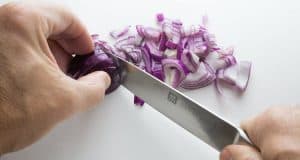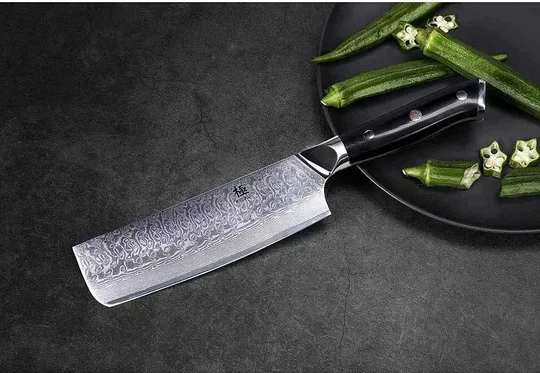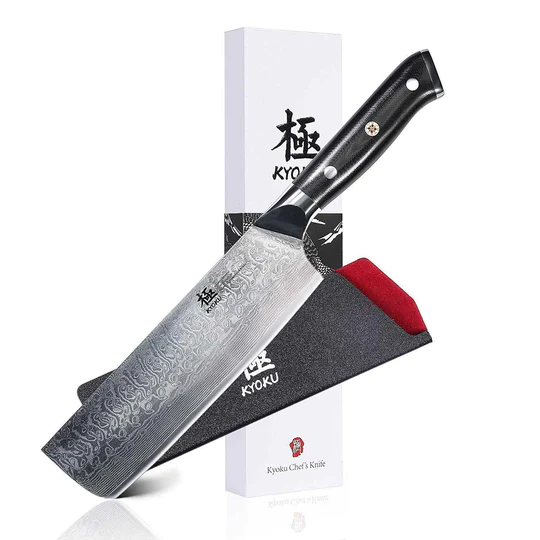


Chopping vegetables is a basic task in many home kitchens. The right knife can make this job easier, faster, and a lot safer. There are plenty of knives out there, but one really shines for slicing and dicing veggies: the Nakiri knife. This Japanese-style blade has a flat, rectangular shape and a blunt tip, which lets you cut straight down and get clean, even slices.
Nakiri knives are meant just for cutting vegetables—not meat or bones. Their thin, sharp blades slide through carrots, onions, cucumbers, and more without squishing or tearing. Some cooks really like them for their ability to make neat, uniform cuts, which is handy for salads and stir-fries.
When you are looking for the best Nakiri Knife, you’ll want to think about the blade material, handle comfort, weight, and size. The steel’s hardness and sharpness matter, but how the knife feels in your hand matters too. Balance and grip definitely affect safety and control.
| Feature | What to Look For |
|---|---|
| Blade Material | Stainless or high-carbon steel |
| Length | 6-7 inches |
| Handle | Comfort, grip, safety |
| Weight/Balance | Feels balanced in our hand |
When choosing a Nakiri Knife, consider these options:
We dug in and found the top Nakiri knives for chopping vegetables with less hassle. Here are our favorites to help you land the right tool for your kitchen.

The Paudin 7″ Nakiri Knife stands out for prepping veggies fast and comfortably thanks to its sharp blade and easy grip.
Pros
Cons
After trying the Paudin Nakiri Knife for dinner prep, we noticed right away how easily it handled even tough veggies like carrots and sweet potatoes. The knife feels light but balanced, so it’s easy to control while chopping. Its Pakkawood handle helps keep your hand from getting tired during longer cooking sessions.
The wave pattern on the blade isn’t just for show. It stops food from sticking to the blade, which makes cleanup faster. Sure, the blade isn’t real Damascus, but it looks nice and stays sharp after multiple uses. The main drawback is you have to wash it by hand, but that’s pretty standard with good knives.
If you want a vegetable chopper that can also handle some meat and general kitchen tasks, the Paudin 7″ Nakiri Knife should make you happy. We’d say it’s a solid daily kitchen knife, but you’ll want to treat the blade with a bit of care so it lasts.

If you want a dependable knife for clean vegetable chopping, this Nakiri from KnifeSaga is a solid option.
Pros
Cons
After using the KnifeSaga Nakiri, we were impressed right away. The blade is extremely sharp and glides through potatoes and peppers. The scalloped blade design keeps slices from sticking, which speeds things up.
The wooden handle fits nicely in our grip and didn’t leave our hand tired, even after a big pile of carrots. The knife feels well balanced, so our cuts stayed steady and even. Its forged blade gives us confidence in its reliability.
On the downside, you really shouldn’t toss it in the dishwasher, even if you’re tempted. The edge is super sharp, so you’ll want to be careful. If you mostly work with veggies and softer foods, the KnifeSaga Nakiri Chef Knife is a practical addition to your kitchen.

If we’re searching for a sharp, reliable knife for slicing vegetables and more, this Nakiri is a solid pick for everyday use.
Pros
Cons
We just tried out the Hoshanho 7-Inch Nakiri Knife, and the first thing we noticed is how sharp the blade is right out of the box. Slicing through carrots, peppers, and even a watermelon was quick and smooth, so meal prep actually went faster. The blade’s flat edge and extra height made it easy to chop straight down without rocking.
While working with this knife, we appreciated how the weight is balanced between the handle and blade. The Pakkawood handle felt sturdy and helped reduce fatigue, even after cutting a big pile of vegetables. For anyone with hand stiffness or grip concerns, the shape really does help. The eye-catching design with the wooden handle and scalloped blade also adds a nice touch to our kitchen.
Cleaning takes a bit of attention since you can’t put it in the dishwasher. We noticed a small spot at the handle’s connection that needed a quick polish, but that was easy enough. Overall, it’s a dependable, versatile kitchen tool we’d reach for again. If you want a practical upgrade, the Hoshanho 7-Inch Nakiri Knife deserves a spot on your list.

If you chop a lot of veggies and want something sharp and reliable, this one stands out for comfort and cutting power.
Pros
Cons
We just used the Kyoku Nakiri to prep a full batch of veggies for stir fry. Cutting through potatoes, peppers, and onions felt almost effortless. The blade glides neatly, which really cuts down the time it takes to get dinner ready.
The handle sits nicely in our hands, even after dicing veggies for a while. We noticed less hand fatigue, especially thanks to the balanced design. Its Pakkawood handle holds up well to splashes and the general mess of daily cooking.
While it needs a quick hand sharpening to reach its peak sharpness, maintenance is fairly easy if you dry it right after washing by hand. The included sheath and case keeps everything safe, but we would prefer if the case was a little sturdier.

This Nakiri knife is a reliable kitchen knife for anyone who wants to slice vegetables quickly and with control.
Pros
Cons
When we tested the Mercer Genesis 7-Inch Nakiri Knife in our kitchen, it made quick work of chopping onions, carrots, and cabbage. The straight blade helped us produce even slices every time, and it stayed sharp through several recipes. Its balance stood out: it never felt too heavy, and we had great control even when working with tough vegetables.
We noticed the Santoprene handle stayed grippy even when wet, so we didn’t have to worry about slipping. After several uses, our hands never felt sore or tired. The overall build quality was solid and felt like it would hold up to daily use.
We had to remember not to put this knife in the dishwasher, because it should be washed by hand to preserve the blade. While that’s normal for high-quality knives, it’s something to keep in mind if you want easy cleanup. The handle, while sturdy, might seem bulky for smaller hands.

We recommend the Milk Street Nakiri Knife for anyone wanting a sharp, easy-to-use knife dedicated to vegetable prep.
Pros
Cons
Cutting vegetables with the Milk Street Nakiri Knife surprised us with just how smooth and quick it felt. The 6.75-inch blade gave us control when slicing through everything from carrots to cabbage, and nothing seemed to stick to the sides, even softer foods like squash slid right off. The sharpness stands out, and it gives very clean cuts with almost no effort.
We noticed the knife feels light, but not flimsy. It’s well-balanced, and our hands didn’t get tired even after prepping a big salad. The broad blade also makes it easy to scoop up chopped veggies, adding to its usefulness. We did take extra care because it is very sharp, which could be intimidating if you’re just learning.
This knife isn’t meant for the dishwasher, so we always washed and dried it by hand to keep it in good condition. The handle, while comfortable, is plastic, which doesn’t feel quite as high end as other options but didn’t affect performance for us.

This is a solid pick for anyone who wants a sharp, reliable knife for cutting vegetables in the kitchen.
Pros
Cons
We found that chopping with this Tuo Nakiri Knife makes meal prep much faster, especially for veggies like carrots, onions, and cabbage. The edge slices cleanly and stays sharper than many knives we’ve tried at this price point. We especially like the balance and heft, which makes it easier to control every cut.
One of the main features we noticed right away is the handle. It’s made from a dense Pakkawood material that’s smooth and surprisingly comfortable, but those with larger hands might wish for a bit more grip. Still, it feels much more stable than most wood-handled knives we’ve used before. The knife feels good in the hand and doesn’t tire us out, even after chopping up a big salad.
This knife is very sharp straight out of the box, so taking care while using and storing it is a must. Cleaning up is straightforward, but this one needs a quick wash by hand. No dishwashers here.
When chopping vegetables the Nakiri is often compared to western chef knives. But there are differences in the blades and handling. Nakiri knives have a flat blade that makes full contact with the cutting board, which means cleaner cuts and no rocking like with curved blades. The thin, rectangular shape helps us slice through vegetables quickly and evenly.
We find that Nakiri knives are gentle on delicate foods, so vegetables don’t get crushed. The straight edge also lets us cut all the way through large vegetables, such as cabbage or sweet potatoes.
Nakiri knives are made just for vegetables, while Santoku knives are good for meat, fish, and vegetables. Nakiris have a straighter edge, which makes them better for push-cutting and straight chops.
Santoku knives use a slight curve for rocking motions, but Nakiris excel when we need thin, even slices from top to bottom. Each knife has its purpose, but Nakiris are best when vegetables are the main focus.
We look for high-carbon steel or stainless steel blades, which hold a sharp edge longer. A comfortable handle helps us control the knife easily when chopping.
A well-balanced knife makes repeated use easier on the wrist. We suggest checking for a blade thickness of around 2 mm to 3 mm for smooth slicing, with a sturdy, easy-to-clean handle.
Many chefs use the Shun Classic Nakiri for its sharp VG-MAX steel and elegant design. The Global G-5 Nakiri is also a favorite, thanks to its lightweight feel and stainless steel build.
For Japanese-made excellence, the Yoshihiro VG-10 Nakiri is another top choice, valued for its edge retention and comfortable handle. These knives are trusted by professionals for daily, heavy use.

America’s Test Kitchen often recommends the Shun Classic Nakiri as a winner for its performance and quality. The Mercer Culinary Genesis Nakiri is praised for being both affordable and efficient.
The MAC Nakiri knives are rated for sharpness, while the Wüsthof Classic Nakiri gets high marks for its durability and German craftsmanship.
Nakiri knives speed up chopping and deliver those clean, straight cuts everyone wants. Nakiris have a balanced feel and are easy to handle, even if you’re stuck prepping veggies for ages.
The top brands are renowned for comfort, sharpness, and minimal effort needed to get nice, even slices. If you’ve got smaller hands, go for the Japanese brands with slimmer handles.

Knife Buzz offers independent product reviews on a wide range of knives used in the kitchen, home, and outdoors. We make it easy for you to find the right knife at the best price.

Knife Buzz offers independent product reviews on a wide range of knives used in the kitchen, home, outdoors and at work.
The Knife Buzz Team are passionate about reviewing knives and we cater to a targeted audience that needs independent advice before purchasing.
KnifeBuzz.com may earn affiliate commissions on some pages of this website. Knife Buzz is a participant in the Amazon Services LLC Associates Program, an affiliate advertising program designed to provide a means for sites to earn advertising fees by advertising and linking to Amazon.com. Amazon and the Amazon logo are trademarks of Amazon.com, Inc, or its affiliates. When you click links to various merchants on this site and make a purchase, this can result in this site earning a commission. Other affiliate programs and affiliations include, but are not limited to, Google AdSense.